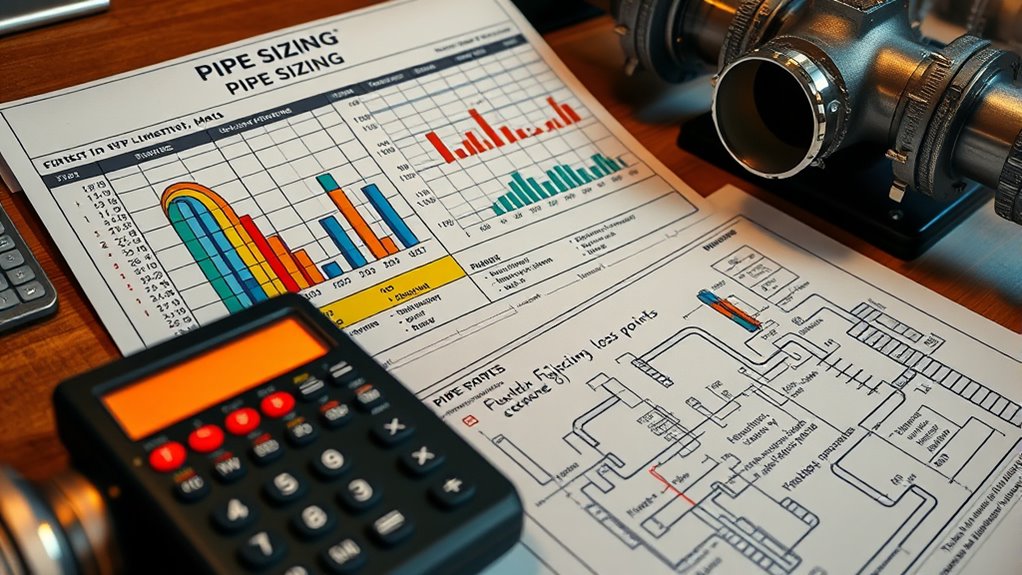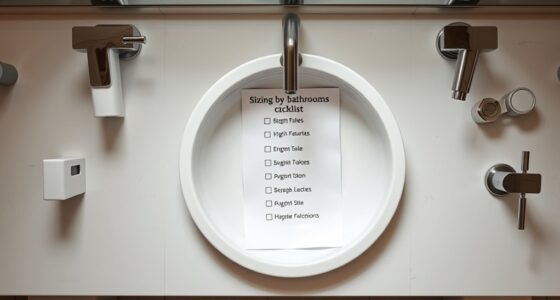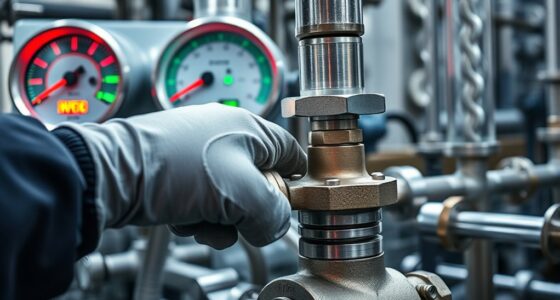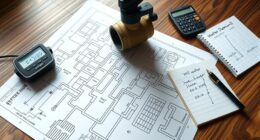To guarantee your piping system works efficiently and safely, you need accurate pipe size and friction loss calculations. Proper sizing reduces pressure drops, prevents leaks, and maintains flow. Consider factors like flow rate, pipe material, fittings, and valves, and use tools like the Darcy-Weisbach or Hazen-Williams formulas. Incorporating these calculations early helps optimize your setup and avoid costly mistakes. Keep exploring to discover detailed steps and tools that make your planning precise and reliable.
Key Takeaways
- Proper pipe sizing minimizes friction loss, ensuring efficient flow and system safety.
- Accurate calculations of pressure drops include fittings, valves, and pipe material effects.
- Selecting appropriate pipe material and diameter optimizes durability and reduces long-term maintenance costs.
- Use Darcy-Weisbach or Hazen-Williams equations with digital tools for precise friction loss estimation.
- Incorporating software and digital charts streamlines calculations, reduces errors, and enhances system performance confidence.
Understanding the Importance of Proper Pipe Sizing
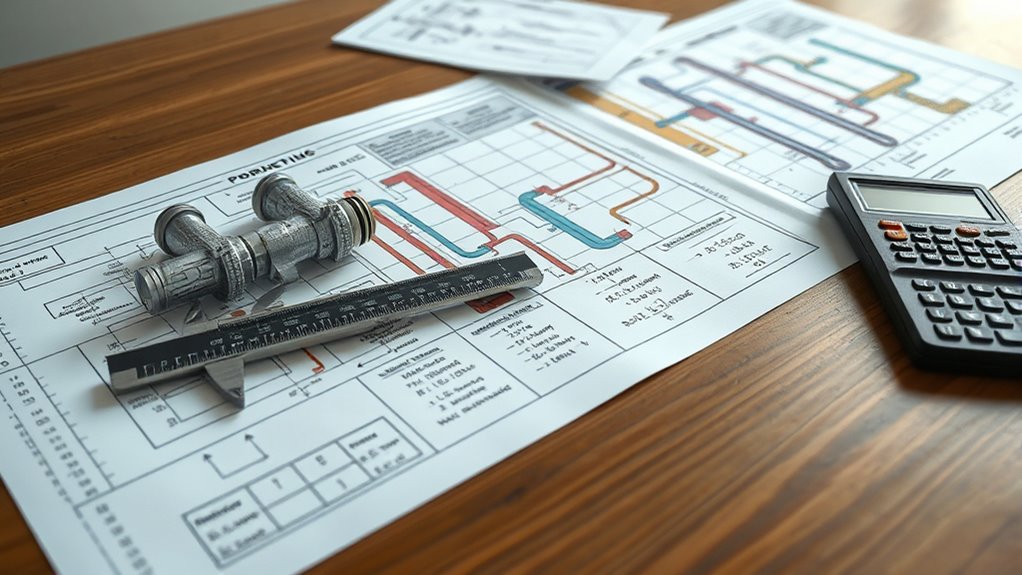
Proper pipe sizing is essential because it directly impacts the efficiency and safety of your plumbing or piping system. Choosing the right pipe material affects how well your system resists corrosion, handles pressure, and lasts over time. Different materials, like copper, PVC, or steel, have unique installation methods that influence the overall performance. Proper sizing ensures that flow rates stay ideal, reducing friction loss and preventing issues like leaks or bursts. When you select the right pipe size, you improve water delivery and system durability. Additionally, understanding how installation methods vary with pipe material helps you avoid mistakes that could compromise safety. Correct pipe sizing, combined with suitable materials and installation techniques, keeps your system running smoothly and efficiently, especially when considering friction loss and how it affects overall system performance.
Determining Flow Rate Requirements for Your System

Understanding how much water your system needs is the first step toward choosing the right pipe size. To do this, you must accurately determine your flow rate requirements through proper flow measurement. Start by identifying your peak demand, which depends on the number of fixtures or equipment using water simultaneously. Keep in mind that different pipe materials can influence flow capacity, so consider how your chosen material affects flow velocity. Measure flow using appropriate tools like flow meters or by calculating based on fixture flow rates. This data helps guarantee your system can handle the required volume without excessive friction loss. Accurate flow rate calculations prevent undersizing, which can cause pressure drops, or oversizing, which wastes material and increases costs. Additionally, understanding discovery – personality test can provide insights into optimizing system design based on user behavior and preferences.
Selecting the Appropriate Pipe Material and Diameter

Choosing the right pipe material and diameter is essential for ensuring efficient flow and durability in your system. You need to consider factors like pipe corrosion resistance and environmental considerations to prevent failures and reduce maintenance.
Selecting appropriate pipe materials and sizes ensures system efficiency and longevity.
Here are key points to guide your selection:
- Match pipe material to environmental conditions—corrosive environments demand corrosion-resistant materials like PVC or HDPE.
- Select a diameter that balances flow capacity with friction loss, avoiding undersized pipes that cause pressure drops.
- Think about long-term durability and maintenance costs, opting for materials that withstand environmental stressors without frequent replacements.
Calculating Friction Loss Using the Darcy-Weisbach Equation

Once you’ve selected the appropriate pipe material and diameter, accurately estimating the pressure loss due to friction becomes essential for system efficiency. The Darcy-Weisbach equation helps you do this by accounting for pipe roughness and flow regime. Pipe roughness, a measure of surface texture, influences how much friction the fluid encounters. The flow regime—laminar or turbulent—affects how you apply the equation; laminar flow simplifies calculations, while turbulent flow requires a friction factor determined through charts or iterative methods. By inputting pipe length, diameter, fluid velocity, and the Darcy friction factor, you can precisely calculate the head loss. Understanding the role of surface texture in pipe roughness can help optimize your system design. This calculation enables you to optimize pipe size, minimize energy use, and ensure efficient fluid transport throughout your system.
Applying Hazen-Williams Formula for Friction Loss Estimation

The Hazen-Williams formula provides a straightforward method for estimating friction loss in water piping systems, especially when dealing with relatively clean, steady flows. It’s an empirical approximation that simplifies calculations, making it popular for quick assessments. However, be aware of its limitations: it’s less accurate for turbulent, highly variable, or contaminated flows. To apply it effectively:
Hazen-Williams offers quick estimates but is less accurate for turbulent or contaminated flows.
- Use the appropriate Hazen-Williams coefficient (C), based on pipe material and condition.
- Recognize that the formula best suits flow ranges where its empirical nature holds true.
- Remember that deviations from ideal conditions can lead to inaccuracies, so consider supplementary methods if precision is critical.
- Incorporating organic and natural juices and their flow characteristics can sometimes influence flow assumptions in practical applications.
Understanding these aspects ensures you use the Hazen-Williams formula accurately and within its intended scope.
Adjusting Pipe Sizing Based on Velocity and Pressure Drop Limits

You need to take into account how velocity affects pipe sizing because high speeds can cause excessive wear and noise. Setting pressure drop limits helps ensure your system maintains proper flow without wasting energy. Balancing these factors is key to optimizing pipe size for efficiency and longevity. Additionally, considering the environmental impacts of your choices can lead to more sustainable system design. Environmental impacts
Velocity Impact on Sizing
Adjusting pipe size based on velocity and pressure drop limits is essential for efficient system design. High velocities can cause increased flow turbulence, which may lead to pipe noise, vibration, and accelerated wear, threatening pipe durability. To optimize sizing, consider these key points:
- Keep velocities within recommended ranges to minimize flow turbulence and maintain smooth operation.
- Higher velocities boost friction loss, requiring larger pipe diameters to offset pressure drops.
- Balancing velocity ensures you avoid unnecessary pipe size increases, saving costs without sacrificing system integrity.
- Monitoring flow velocity helps ensure the system operates within optimal parameters, reducing the risk of equipment failure.
Pressure Drop Constraints
Managing pressure drop constraints is vital when sizing pipes to guarantee efficient flow without overburdening the system. Too high a pressure drop can cause excessive pipe noise, making your system noisy and less reliable. It can also lead to increased wear and corrosion, reducing pipe lifespan. To prevent this, you should set pressure drop limits based on your system’s capacity and the acceptable velocity range. Keeping flow velocities within recommended limits minimizes noise and corrosion risk. Adjust pipe sizes accordingly to balance pressure loss and flow efficiency. Additionally, considering Hyundai Tuning options can enhance system performance and durability by optimizing engine and component efficiency. By carefully managing pressure drop constraints, you assure a quieter operation, extend pipe durability, and maintain peak performance without sacrificing velocity or increasing friction losses.
Incorporating Fittings and Valves Into Friction Loss Calculations
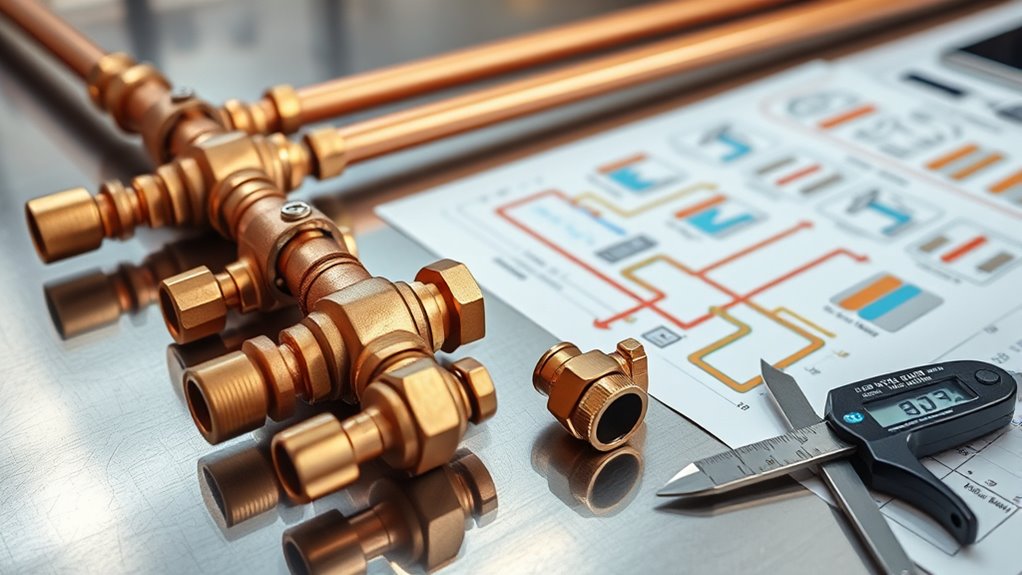
Fittings and valves can substantially increase friction loss in a piping system, so it’s vital to account for their effects accurately. Ignoring these components can lead to underestimated pressure drops, affecting performance. To do this effectively:
- Calculate the fitting pressure loss using manufacturer data or standard charts, which helps determine the impact of each fitting on overall pressure drop.
- Include valve sizing in your calculations; larger valves generally cause less pressure loss, but improper sizing can considerably reduce flow efficiency.
- Sum the pressure losses from fittings and valves with the pipe friction loss to get a total pressure drop, ensuring your system maintains adequate flow and pressure throughout.
Using Software Tools and Charts to Streamline Your Calculations

Using software tools and charts can considerably simplify the process of calculating pressure losses in your piping system. Software automation allows you to input pipe dimensions, flow rates, and fluid properties, instantly generating accurate friction loss calculations. Digital charts, such as Moody diagrams and friction factor tables, provide quick references to determine head loss without manual computations. These tools reduce errors and save time, especially for complex systems. Many programs also include features to account for fittings, valves, and pipe material differences, ensuring thorough analysis. Incorporating Kia Tuning insights can help optimize the system for specific vehicle performance goals. By leveraging software and digital charts, you can streamline your planning process, make informed decisions faster, and optimize your piping design with confidence. This approach ensures precision and efficiency in your pressure loss calculations.
Frequently Asked Questions
How Do Temperature Variations Affect Pipe Size and Friction Loss?
Temperature variations cause pipe size and friction loss to change due to temperature expansion, which can increase pipe diameter slightly as it heats up. Higher temperatures also affect material conductivity, impacting flow efficiency. As pipes expand with temperature, friction loss may decrease if diameter increases, but if materials weaken or degrade, flow resistance can increase. Always account for temperature effects to guarantee accurate pipe sizing and ideal flow performance.
What Safety Margins Should Be Included in Pipe Sizing Calculations?
You should include safety margins of about 10-20% in your pipe sizing calculations to account for unexpected pressure drops and future expansion. Consider pipe material, as some materials have higher friction loss rates, and guarantee your installation standards are met to prevent issues. Including these safety margins helps ensure reliable flow, reduces maintenance, and keeps your system compliant with safety regulations, providing long-term operational security.
How Often Should Pipe Systems Be Re-Evaluated for Friction Loss?
Think of your pipe system as a living organism that needs regular checkups. You should re-evaluate friction loss every 1-2 years, or sooner if you notice issues like reduced flow. Regular pipe maintenance and system upgrades guarantee efficiency and safety. By staying proactive, you prevent costly failures and keep your system running smoothly, just like tending to a garden ensures healthy growth.
Can Pipe Corrosion Impact Friction Loss Over Time?
Yes, pipe corrosion can impact friction loss over time. Corrosion effects weaken the pipe material, increasing roughness inside the pipe and reducing its durability. As corrosion progresses, it causes buildup and pitting, which increases friction loss and decreases flow efficiency. Regular inspections and maintenance are essential to address corrosion effects early, ensuring the pipe material remains durable and friction loss stays within acceptable limits for ideal system performance.
How Do Local Codes Influence Pipe Size and Friction Loss Planning?
Isn’t it true that local codes are the compass guiding your project? They directly influence your pipe size choices and friction loss planning by enforcing regulatory compliance. These codes often specify material selection, which affects flow efficiency and durability. Ignoring them can lead to costly revisions or penalties. Always consult local regulations early to guarantee your design aligns, keeping your project on track and within legal bounds.
Conclusion
By accurately sizing your pipes and calculating friction loss, you can prevent system failures and save up to 20% on energy costs. Imagine reducing pressure drops enough to save gallons of water daily—that’s like watering a garden the size of a football field every week! Proper planning guarantees smooth flow, efficiency, and longevity. Don’t skip these calculations; they’re your best tools for designing a reliable, high-performance piping system that stands the test of time.
